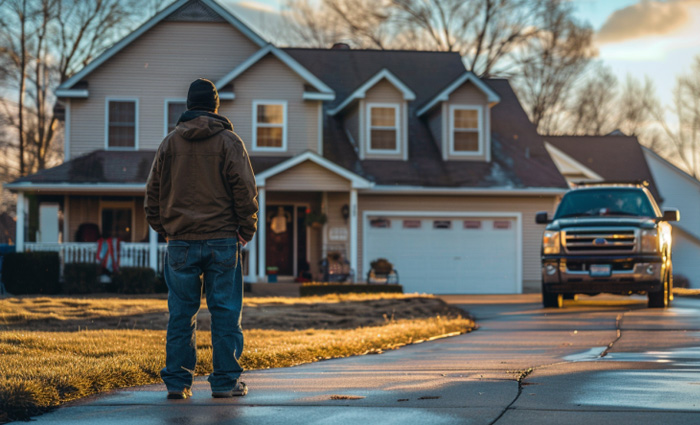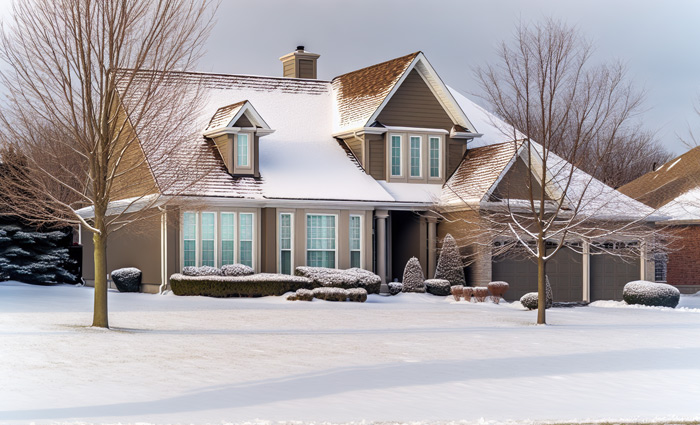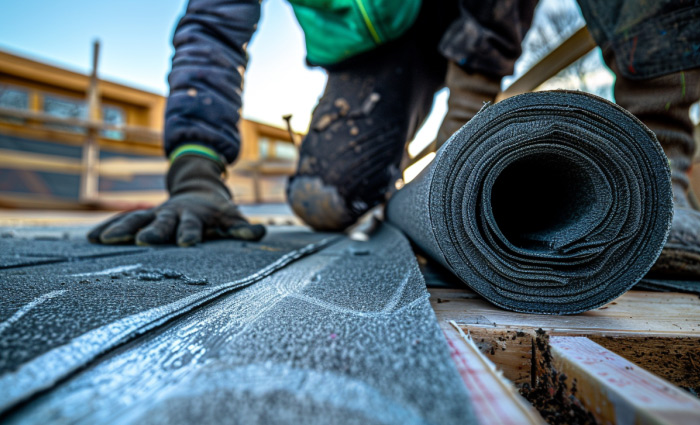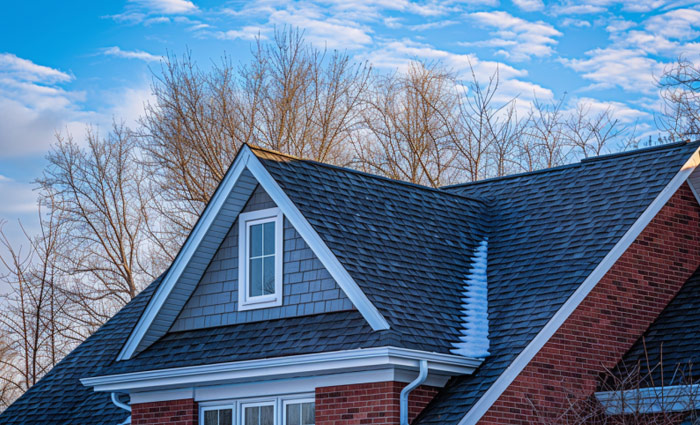Can you do roofing in the winter? Yes, it can be done. The cold season poses certain challenges, like brittle materials and safety risks, yet these can be managed with expertise. This article outlines the essential details homeowners and contractors should consider for successful roofing endeavors during winter without giving into the temptation to halt work until spring.

Key Takeaways
- Cold weather presents significant challenges for roofing, including brittle materials and ineffective adhesives, which necessitate specialized techniques and lengthen project timelines.
- Winter roofing can offer advantages such as quicker project completion due to contractors’ lower workload, potential cost savings, and strategic timing for leak repairs or aesthetic improvements.
- Ensuring high-quality winter roof installations requires meticulous planning, proper material preparation, modified installation tactics, and prioritizing the safety of roofers and homeowners.
Navigating the Challenges of Winter Roof Installation
The cold winter months pose several challenges for roof installations. As the temperature drops, the impact on roofing materials becomes more evident. Some of the challenges include:
- Asphalt shingles can become brittle in cold temperatures, leading to potential substandard installation.
- Standard adhesives do not perform well in freezing temperatures, compromising their effectiveness.
- Roofing companies may hesitate to undertake winter installations due to the added difficulties cold weather imposes on the quality and duration of roof replacement.
Another hurdle is the extended timelines required for roof work during winter. Every step, from removing old roofing materials to installing new asphalt shingles, requires extra care. This meticulous approach is necessary to ensure the roof’s longevity, but it can lengthen the duration of the roofing project. Therefore, homeowners contemplating a winter roof installation should consider these potential delays when planning.
Despite these hurdles, winter roof replacements should not be completely ruled out. Experienced roofing professionals can navigate these hurdles, ensuring your new roof is installed to the highest standards. The key lies in understanding the impact of cold weather on the roofing process and managing these risks with proper application techniques, as we will explore in the following sections.
Impact on Asphalt Shingles and Other Materials
Let’s analyze further the effects of cold weather on roofing materials. Asphalt shingles are particularly vulnerable to cold temperatures. When temperatures fall below 40 degrees Fahrenheit, most asphalt shingles can become brittle and more prone to breakage during installation. Consequently, this can result in a roof that fails sooner than expected. This makes it crucial for roofing contractors to use specialized adhesives when installing asphalt shingles in temperatures below 70 degrees Fahrenheit to maintain elasticity and create a proper seal.
Aside from the shingles themselves, other materials also need special attention and should be used. For instance, ice and water protector membranes should be installed under shingles to protect against water penetration due to ice dams or wind-driven rain, particularly around chimneys, vents, and rooftop structures. Thus, homeowners must ensure that their chosen roofing company is well-equipped to manage these cold weather challenges for a successful winter roof installation.
Handling Tools and Equipment in Freezing Temperatures
The challenges extend beyond materials to the tools and equipment used in the installation process. Cold temperatures can affect roofing equipment such as nail guns and compressors, leading to imperfections in the roof installation process. As colder temperatures exacerbate these issues, the water in the compressor airlines can freeze and block the airflow, affecting the performance of nail guns and compressors.
Moreover, nail guns may jam more frequently in cold temperatures, requiring adjustments to the pressure to avoid damaging the shingles. Therefore, roofing contractors must be familiar with and prepared to handle these technical difficulties to ensure the roof installed in the winter is just as durable and long-lasting as a roof installed in warmer weather.
Extended Timelines for Roof Work
As previously noted, winter roof installations typically require more time than those in warmer seasons. Removing all snow and debris before starting roof work in winter is essential to save time and prepare the area. For successful adhesion of roofing materials in cold weather, the roof surface must be properly smoothed and flattened.
Safety also plays a significant role in extending winter roof work timelines. Implementing temporary guardrails is a crucial safety precaution to prevent falls when working on icy rooftops. While necessary for a successful winter roof installation, these additional steps can add time to the overall project. However, the extra time taken ensures the roofing crew’s safety and the quality of the roof replacement.
The Pros of Winter Roofing: When Cold Weather Can Be Beneficial

Having examined the challenges, it’s time to discuss the benefits of winter roofing. Winter, with its unique challenges, does present some valuable opportunities. As the demand for roofing jobs often decreases during the colder months, roofing contractors have fewer jobs lined up, leading to quicker project turnarounds. This could mean that your roof replacement project could start sooner and get completed faster than it might during the peak roofing seasons.
Additionally, some other benefits of winter roofing include:
- Lower rates and incentives offered by roofing companies to homeowners willing to undertake roofing projects in the off-season
- Increased availability of roofing contractors
- Less competition for scheduling and resources
These cost savings, combined with the increased availability of roofing contractors, can make winter an attractive time for many homeowners to consider their roofing needs.
Although cold weather presents challenges, it doesn’t hinder roofing materials from functioning effectively. Thus, winter roof installations remain a viable option. In the following sections, we’ll delve deeper into the less busy schedules for roofing contractors and potential savings on roofing needs during winter.
Less Busy Schedules for Roofing Contractors
As noted, one of the significant advantages of winter roofing is the increased availability of roofing contractors. Roofing tends to slow down in the winter season, resulting in greater contractors’ availability. This increased availability can be beneficial for homeowners who need urgent roof replacements. You no longer have to wait for weeks for an available slot; with more flexible schedules in winter, roofers can often start and finish jobs more quickly than during busier seasons.
This flexibility can also be beneficial if your roof replacement project is complex and requires more time. With fewer jobs, your roofing contractor can dedicate more time and attention to your project, ensuring that every detail is meticulously addressed. This can lead to a higher-quality installation and a more durable roof.
Potential Savings on Roofing Needs
Winter roofing can also offer potential savings for homeowners. During the winter, some roofing companies offer incentives and lower rates to homeowners willing to undertake roofing projects in the off-season. These incentives could range from discounted rates to special winter promotions designed to attract new customers and maintain sales during slower seasons.
Additionally, in colder months when business typically decreases, roofers might be more willing to negotiate prices, potentially leading to further cost savings for homeowners. Discounts from roofing material suppliers during winter can mean lowered material costs for homeowners planning roof replacements or repairs. Some companies even offer special deals, such as free roof inspections with quotes to encourage homeowners to choose the winter season for their roofing needs. These potential savings make winter an attractive season for homeowners considering roof replacements.
Ensuring Quality: Best Practices for Winter Roof Installations
While winter roofing presents unique challenges, quality installations are achievable with meticulous planning, proper material preparation, and adapted installation techniques. Professional roofers plan meticulously before starting winter installations to ensure high-quality results and safety despite the challenging conditions. Conducting roof replacements in the winter offers an opportunity for preemptive maintenance that can contribute to a longer lifespan for the new roof.
In the following subsections, we will discuss the specific best practices that seasoned roofing professionals utilize to achieve successful winter roof installations. These include preparing and warming materials and adapting installation techniques to suit cold weather conditions.
Preparing and Warming Materials
To ensure successful winter roof installations, roofers must ensure that materials are warmed and stored correctly. This is particularly important for materials like asphalt shingles, which must be sufficiently flexible during installation. In low-temperature conditions, this may require warming the shingles. In practice, this involves spreading shingle bundles on the roof to absorb heat from the sun and warming them up to make them more pliable for installation.

In addition to warming, proper storage of shingles is also critical. Here are some guidelines to follow:
- Shingles should be stored at temperatures above 50 degrees Fahrenheit
- Keep shingles off the ground and store them flat
- Cover shingles to prevent them from becoming brittle and to protect them from precipitation
- Consider using Powerblanket Hot Boxes, which maintain roofing materials at the optimum temperature range between 100°F and 120°F, ensuring materials are ready for winter installations.
Adapting Installation Techniques
Adapting installation techniques for cold weather is another crucial aspect of successful winter roof installations. For example, in cold weather, when warmth is not sufficient to activate the self-sealing strips on shingles, professionals resort to:
- Manually applying roofing cement to ensure wind resistance
- Using specialized adhesives for each shingle below 40 degrees Fahrenheit
- Increasing the number of nails from four to six per shingle to secure them in cold conditions
Other installation techniques include using membranes over warm weather roll roofing to prevent buckling and using open metal valleys instead of woven ones to prevent damage from bending shingles. These adapted techniques and careful adherence to the manufacturer’s cold temperature application instructions are critical for a successful installation and maintaining the product warranty.
Prioritizing Roofer and Homeowner Safety During Winter Installations

Safety remains a fundamental priority for all construction projects, including roof installations. Safety becomes even more crucial during winter installations as roofing contractors face increased health risks due to severe weather conditions. For instance, roofers are at risk of:
- Hypothermia can occur if the core body temperatures drop too low, highlighting the need for wearing adequate layers of clothing.
- Frostbite, particularly affecting extremities, necessitates using gloves, warm socks, boots, and headwear.
- Dehydration as heavy clothing may cause sweating, and icy winds can contribute to water loss.
The safety of the home itself is also a critical consideration. Here are some precautions to take to protect your roof and home during the winter roofing installation process:
- Proper underlayment and ice and water shielding are essential to protect the home from harsh winter weather and potential installation delays.
- Trim branches within six feet of the home to prevent them from causing damage to the roof.
- Deal with potentially dangerous trees to prevent structural damage to the roof.
These precautions will ensure that your roof and home are protected during installation.
Addressing Slippery Conditions
Managing slippery conditions is one of the most pressing safety concerns during winter roofing. Roofers leverage tools such as roof rakes to reduce snow loads, decreasing the potential for icy, slippery surfaces on the roof. Exercising caution when removing snow and ice from roofing surfaces is crucial to prevent surface damage and crew slippage.
Moreover, to ensure the safety of the roofing crew, the following measures should be taken:
- Ladders must be kept ice-free and safely anchored, particularly where they contact the eaves.
- Fall protection equipment should be used.
- Weather conditions should be monitored closely, and work should be delayed during intense snow or ice storms.
These measures, while adding to the time and complexity of the job, are crucial to ensure the safety of both the roofing crew and the homeowners.
Protecting the Home from the Elements
Shielding the home from the elements during winter roof installations is paramount. Apart from ensuring the safety of the roofing crew, homeowners must also consider the protection of their homes from harsh winter weather and potential installation delays. Installing the correct underlayment is crucial for protecting the house from elements during roof installation processes in winter. Underlayments featuring ice and water shielding provide robust protection for the rooftop against harsh winter weather and installation delays.
In addition, packed snow can exacerbate the loosening of damaged flashings, increasing the likelihood of leaks during winter installations. Also, proactively trimming branches within six feet of the home and dealing with potentially dangerous trees can prevent structural damage to the roof. These precautions help protect your home during installation and ensure your new roof’s longevity.
Successful Winter Roof Replacements

Let’s discuss some successful case studies to emphasize winter roof replacements’ viability further. These real-world examples will showcase how proper planning, material selection, and installation techniques can lead to successful roof installations, even in harsh winter conditions.
One case study highlights how real-world performance feedback when testing under rain and snow confirmed the durability of the asphalt shingle roof installation. Also, this case demonstrated how roofing companies can counter cold weather challenges by storing shingles in climate-controlled environments and using thermally activated asphalt shingles that bond well without sunlight.
Another case study emphasizes the importance of material selection for winter roofing. In this case, we used rubber composite shingles that enhanced the viability of roofing during cold months due to their ability to handle extreme temperatures.
These case studies demonstrate that successful roof replacements are possible during winter with suitable materials, planning, and installation techniques.
Planning Your Roof Replacement Project: Timing and Considerations
As mentioned, winter roofing can be a suitable option for numerous homeowners. However, the timing of a roof replacement project is an important consideration and should be based on several factors. Seasonal factors, homeowner needs, and local weather patterns all play a part in determining the best timing for roof installations. While fall is generally considered the best time for a roof replacement due to comfortable temperatures and mild weather conditions, summer and spring also offer their advantages.
However, planning a roof replacement in winter strategically allows homeowners to detect and promptly address leaks or damage and maximize curb appeal by springtime. When scheduling a roof replacement, you should also consider the homeowner’s needs, personal preferences, and your region’s specific climate and local weather patterns.
In conclusion, while winter roof replacements present unique challenges, they also offer unique benefits. With careful planning, optimized materials, and safety precautions, winter roof installations can be as successful as those in warmer seasons. Moreover, they can often be completed more quickly and at a lower cost, offering tangible benefits to homeowners.
Winter Roofing Summary
In this blog post, we’ve explored the unique challenges and opportunities that come with winter roof installations. From the impact of cold weather on roofing materials and tools to the potential for quicker project turnarounds and cost savings, winter roofing is a complex yet feasible option for many homeowners.
While it’s true that winter roof replacements require meticulous planning, careful material preparation, and adapted installation techniques, they also offer an opportunity for roofing contractors to address roofing needs during a quieter season. With the right approach and an experienced roofing contractor, you can ensure a successful and durable installation, regardless of season.
Frequently Asked Winter Roofing Questions
These are a few winter roofing questions we hear often:
What temperature is too cold for roofing?
Roofing becomes too cold when temperatures drop below 40°F (4°C), as many roofing products require the sun’s heat to activate their adhesive properties.
Is it OK to replace a roof in the winter?
It is generally acceptable to replace a roof in the winter but not recommended when the temperature drops below 40 °F, as it can damage the roofing materials and impact the equipment’s functioning.
Do people work on roofs in the winter?
Roofing can be done in the winter, depending on the temperatures and weather conditions.
How can the quality of a winter roof installation be ensured?
To ensure the quality of a winter roof installation, it is essential to engage experienced roofing professionals who can navigate the challenges of winter roofing through meticulous planning, proper material preparation, and adapted installation techniques. This will help ensure a successful and durable installation.
How can I plan my roof replacement project?
Consider seasonal factors, your needs, and local weather patterns when planning a roof replacement project. Winter replacements can be successful with proper planning and approach.
For the original version of this article visit: https://roofersthevillagesfl.com/can-you-do-roofing-in-the-winter/

No comments:
Post a Comment
Note: Only a member of this blog may post a comment.